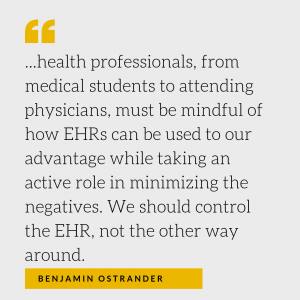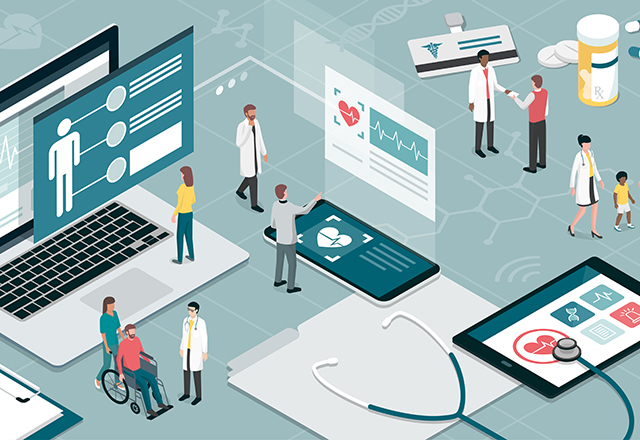While entering a clinic room one day, I closely followed the attending physician as she greeted the patient and made introductions. That morning I was participating in a form of learning that is all too common in medical school: passive observation. “Now let me just pull up the note,” the doctor said to the patient, his wife and me. She stepped up to the computer, placed awkwardly in the corner of the room, making simultaneous eye contact with the patient and documentation impossible. She clicked the icon to open the EHR software. Two minutes later, it opened, then crashed. She apologized, and we all waited. Eventually, the New History & Physical (H&P) template opened, and she finally asked, “So what brings you in today?” What proceeded was not so much a conversation but a reading of a premeditated clinical script, and a click storm of charting, billing and documentation. “This isn’t why I went into medicine,” I thought to myself.
Abraham Verghese described this very phenomenon in a recent New York Times Magazine article: “When students arrive on the wards full time . . . they are shocked to find that the focus on the ward doesn’t revolve around the patients but around the computers lining the bunkers where students, residents and attending physicians spend the majority of their time, backs to one another.” Just as I have transitioned from bright-eyed, idealistic premedical student to less optimistic almost-doctor, EHRs have cemented their role in modern health care and become a favorite topic of conversation and recipient of blame. Studies have shown that for every hour physicians spend on clinical face time with patients, two hours are spent on EHRs and other clerical desk work. The EHR is chiefly a billing instrument, not a health record, and this has led to degradation of the doctor-patient relationship, increased administrative burden, more data-entry requirements, reduced efficiency, and physician burnout.
Yet EHRs have also led to the creation of detailed, readable and searchable medical histories. These digital repositories have improved continuity and coordination of care among providers, especially when they are in the same network (but frustratingly not for out-of-network providers, due to poor EHR interoperability). The vast amounts of data from these records are increasingly used in promising big data innovations, artificial intelligence and large-scale clinical research to make clinical care more evidence-based, intuitive and efficient. That morning in clinic, these useful aspects of the EHR helped the physician quickly establish the facts of previous visits, including detailed test results and conclusions regarding the cause of the patient’s dizziness.
 As medical students, we are privy to this double-edged sword of EHRs. Perhaps the most relevant effect of EHRs on medical student training revolves around note templates. Prefabricated templates are widely used to improve efficiency, save time, add detail and structure the clinical encounter. When used appropriately, templates can be incredibly helpful, but they are very frequently misused. Providers copy-forward notes without updating the text. Complete physical exams are auto-inserted when only one or two exam maneuvers are performed. Pages and pages of lab and radiology reports and other information are automatically inserted on each and every note, making them far too long to be readable. As a result, medical students have become masterful information winnowers, separating out pertinent and important bits of information from the vast noise in modern digital medical charts. We often have more time than other members of the health care team to carefully comb health records and generate valuable summaries of relevant information about a patient’s medical history.
As medical students, we are privy to this double-edged sword of EHRs. Perhaps the most relevant effect of EHRs on medical student training revolves around note templates. Prefabricated templates are widely used to improve efficiency, save time, add detail and structure the clinical encounter. When used appropriately, templates can be incredibly helpful, but they are very frequently misused. Providers copy-forward notes without updating the text. Complete physical exams are auto-inserted when only one or two exam maneuvers are performed. Pages and pages of lab and radiology reports and other information are automatically inserted on each and every note, making them far too long to be readable. As a result, medical students have become masterful information winnowers, separating out pertinent and important bits of information from the vast noise in modern digital medical charts. We often have more time than other members of the health care team to carefully comb health records and generate valuable summaries of relevant information about a patient’s medical history.
Importantly, EHRs and accompanying templates now play an integral role in structuring clinical encounters. “The EHR is a lot more than merely an electronic version of the patient’s chart. It has also become the control panel for managing the clinical encounter through clinician order entry,” wrote Robert Wachter and Jeff Goldsmith in the Harvard Business Review. These templates have changed the way I learn history-taking and clinical reasoning. Instead of forming my own mental map, creating a conceptual structure through trial and error, and asking impromptu questions based on the evolution of the interview, I rely on the script in the EHR. Many specialists now have templates for very specific patient complaints. If the patient presents with dizziness, just insert “.ccdizzy” — the “chief complaint dizziness” SmartPhrase — and all the relevant questions for dizziness are inserted into the note.
In some ways, templates are incredible learning tools that outline what essential features of the history and physical exam should be covered for each presenting problem. Conversely, they can prevent medical students from attempting, formulating and internalizing the H&P process. While my H&Ps are generally less complete when I sit down with pen and paper and record notes on a blank page as I go, I find I learn and internalize clinical reasoning strategies and H&P structuring better than when I’m reading off a script.
Ultimately, EHRs must evolve toward instruments of patient care and physician function rather than burdensome, frustrating and inefficient billing and regulatory tools. In the meantime, health professionals, from medical students to attending physicians, must be mindful of how EHRs can be used to our advantage while taking an active role in minimizing the negatives. We should control the EHR, not the other way around.
